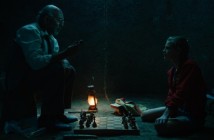
Editor’s Notes: Big Game opens in limited theatrical release this Friday, June 26th.
Imagine an E.T.-Cliffhanger crossover with Samuel L. Jackson as the extra-terrestrial and a little Finnish boy as Sylvester Stallone and you might not be terribly far away from Big Game, Jalmari Helander’s endearingly unoriginal follow-up to the bonkers breakthrough that was 2010’s sadistic-Santa romp Rare Exports. Gleefully riffing on the kind of absurd action cinema since superseded by superheroes innumerable, this snow-set showdown between capital-T terrorists and the US president they’ve shot out of the air fittingly ups the stakes—and the budget; it’s the most expensive production ever to come out of Finland—from the director’s earlier efforts, in the process offering up an endlessly entertaining—and even intermittently interesting—throwback to the fire-powered fun of yesteryear.
Helander has made a movie whose necessarily unsustained stakes can’t help but make the space between a bit of a drag.
The obvious influence is fellow Finn Renny Harlin, to whom Helander’s courting of a major Hollywood star and expansion into explosive territory might make him seem heir apparent, but it’s less Cliffhanger and Die Hard 2 the new movie calls to mind—though from its entertainingly evil-for-evil’s-sake foes to an excess of cheesy dialogue, both often come rushing—than his recent Devil’s Pass, which similarly slummed it in snowy climes before all-too occasionally erupting in phenomenal fun. That’s perhaps primarily the case here due to an uneven allocation of budget; bookending his narrative with a pair of particularly flashy set pieces, Helander has made a movie whose necessarily unsustained stakes can’t help but make the space between a bit of a drag.

Blame a script that can never quite decide between pastiche and parody: Helander’s affection for his film’s forebears is plain to see, but he’s keenly aware too of the flimsiness of their plots and personae; in equally attempting to send them up and celebrate them, this effort eventually arrives at a point of aimless self-awareness, too obsessed with appearance to ever entirely embrace the manic fun this plot promises (there’s no stalactite impalement here!). That’s a shame, given the deliriously decadent display of incessant invention that was the director’s last effort: if Big Game’s action is recognisably redolent of Rare Exports’, it’s only as an evidently under-done equivalent, the PG-13 answer to a hard-R original that a cynic might single out as a Hollywood tryout.
Blame a script that can never quite decide between pastiche and parody: Helander’s affection for his film’s forebears is plain to see, but he’s keenly aware too of the flimsiness of their plots and personae.
But one blissful holdover of Helander’s back catalogue—especially that earlier feature’s two superb source shorts—is his tireless deconstruction of myth, and here he has one every bit as big as Santa himself to deflate. As a panicky POTUS desperately dependant on the help of a thirteen-year old boy, Jackson is here more interesting than he’s been in an age, efficiently enabling the movie’s masculinity-interrogating undertones with a perceptive play on his iconic action star persona. Whether fearfully fleeing his missile-targeted plane or feebly failing to land a punch in a decidedly one-sided fight, his President Moore is a far cry indeed from the kind of kick-ass commander-in-chief anyone might rightly have expected him to play.
It’s for that, and for the endearing interaction he shares with Onni Tommila—whose rite-of-passage hunting trip is just as crucial a component of Helander’s look at the meaning of manhood—that Big Game overcomes the more egregious action excesses into which its one-liner-laden last act descends. Helander hasn’t made anything at all essential here, but nestled in his determinedly derivative work is the sort of fresh dressing that displays, if never develops, the same promise put forward in his prior endeavours. It can be a mixed blessing for a young foreign filmmaker if Hollywood comes a-courtin’, but when the studios knock on Helander’s door, we can be sure at least it’ll be to their benefit.
Helander hasn’t made anything at all essential here, but nestled in his determinedly derivative work is the sort of fresh dressing that displays, if never develops, the same promise put forward in his prior endeavours.



